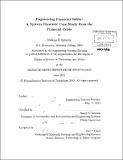| dc.contributor.advisor | Nancy G Leveson. | en_US |
| dc.contributor.author | Spencer, Melissa B. (Melissa Beth) | en_US |
| dc.contributor.other | Massachusetts Institute of Technology. Technology and Policy Program. | en_US |
| dc.date.accessioned | 2012-09-13T19:00:52Z | |
| dc.date.available | 2012-09-13T19:00:52Z | |
| dc.date.copyright | 2012 | en_US |
| dc.date.issued | 2012 | en_US |
| dc.identifier.uri | http://hdl.handle.net/1721.1/72903 | |
| dc.description | Thesis (S.M. in Technology and Policy)-- Massachusetts Institute of Technology, Engineering Systems Division, Technology and Policy Program, 2012. | en_US |
| dc.description | Cataloged from PDF version of thesis. | en_US |
| dc.description | Includes bibliographical references (p. 103-105). | en_US |
| dc.description.abstract | There is currently much systems-based thinking going into understanding safety in complex socio-technical systems and in developing useful accident analysis methods. However, when it comes to complex systems without clear physical components, the techniques for understanding accidents are antiquated and ineffective. This thesis uses a promising new engineering-based accident analysis methodology, CAST (Casual Analysis using STAMP, or Systems Theoretic Accident Models and Processes) to understand an aspect of the financial crisis of 2007-2008. This thesis demonstrates how CAST can be used to understand the context and control problems that led to the collapse and rapid acquisition of the investment bank Bear Stearns in March 2008. It seeks to illustrate the technological and regulatory change that provided the context for the Bear Stearns accidents and then demonstrates how a top-down systematic method of analysis can produce more insight into the accident than traditional financial accident investigations such as congressionally-mandated inquiries. | en_US |
| dc.description.statementofresponsibility | by Melissa B. Spencer. | en_US |
| dc.format.extent | 105 p. | en_US |
| dc.language.iso | eng | en_US |
| dc.publisher | Massachusetts Institute of Technology | en_US |
| dc.rights | M.I.T. theses are protected by
copyright. They may be viewed from this source for any purpose, but
reproduction or distribution in any format is prohibited without written
permission. See provided URL for inquiries about permission. | en_US |
| dc.rights.uri | http://dspace.mit.edu/handle/1721.1/7582 | en_US |
| dc.subject | Engineering Systems Division. | en_US |
| dc.subject | Technology and Policy Program. | en_US |
| dc.title | Engineering financial safety : a system-theoretic case study from the financial crisis | en_US |
| dc.title.alternative | System-theoretic case study from the financial crisis | en_US |
| dc.type | Thesis | en_US |
| dc.description.degree | S.M.in Technology and Policy | en_US |
| dc.contributor.department | Massachusetts Institute of Technology. Engineering Systems Division | |
| dc.contributor.department | Technology and Policy Program | |
| dc.identifier.oclc | 808492853 | en_US |

